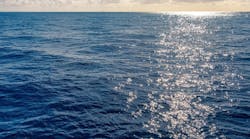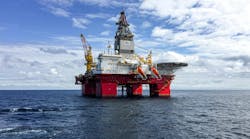Since the 1980s, the Barents Sea’s oil and gas reserves have been compared with those of the Gulf of Mexico. Until now, the Barents petroleum treasures have remained intact due to lack of technology and the extreme fragility of the Barents ecosystem.
However, as the depletion rate grows in the traditional petroleum production areas, multinational oil and gas companies are working on new offshore technologies and will shift their operations more and more to the north.
With that in mind, multinationals seem eager to turn the Barents Sea into the GoM. In 2002, Statoil launched its Snøhvit project in the Norwegian sector of the Barents Sea. It will provide the US East Coast and Spain with LNG starting in 2006. In 2004-2005, some of the world’s major operators applied to become Gazprom’s partners in development of Shtokman, the world’s largest gas field.
Three in one
First production from the Barents Sea will come from three fields with established commercial potential: Prirazlomnoe, Snøhvit, and Shtokman.
So far, Prirazlomnoe is the only oilfield under development in the Barents. First oil will travel to Europe from Prirazlomnoe in 2005. However, it may be delayed because of problems encountered during conversion of the rig’s topsides, which was originally built for the North Sea’s Hutton TLP platform. According to Andrew Winterbottom, general manager of Amec Oil and Gas in Russia, steel used in the topside was not meant for the harsh-weather environment of the Barents.
“Prirazlomnoe’s recoverable reserves are estimated at 75 million tons of oil,” Ivan Chernov, CEO of Sevmorneftegaz, says. “According to our objectives, they shall be recovered within 22 years, based on the production-sharing agreement terms. Annual production will peak at 6.5 million tons in 2010 and will remain at the peak level for five years.”
Sevmorneftegaz is a 100% subsidiary of Gazprom, which holds licenses for both Prirazlomnoe and Stokman fields. Prirazlomnoe’s oil will be shipped to Rotterdam via the non-freezing Russian port of Murmansk.
The next Barents Sea field to comeonstream is expected to be Snøhvit in the Norwegian sector, where Statoil is the only petroleum company operating so far. “Snøhvit will annually supply the US market with up to 2.4 bcm of LNG for 17 years, from 2006 to 2023,” Henrik Carlsen, senior vice president of Statoil, says. Statoil is determined to explore the Barents further to find new fields to bring more gas to the LNG plant on the Melkøya island.
Finally, Shtokman, also known as Shtokmanovskoe, holds estimated reserves of 110 tcf of gas. “The Shtokman gas field will be the most efficient source for LNG deliveries to the US from Russia,” says Alexander Ryazanov, vice chairman of the Gazprom management committee. “This field may produce up to 100 bcm annually, and we will start exporting Shtokman gas no later than 2010.”
To get a clearer picture of the world offshore technologies and the international LNG market, Gazprom has signed short-term memoranda of understanding with seven international majors: Statoil, ChevronTexaco, PetroCanada, ConocoPhilips, ExxonMobil, Royal Dutch/Shell, and Hydro. Gazprom’s final decision on Shtokman depends not only on the partner, but also on its readiness to be subordinate in the project while making a serious investment.
The minimal cost of Shtokman is estimated at $10 billion, but it is not known yet whether Shtokman will become a PSA. According to Ryazanov, “in the next couple of months, together with foreign companies, Gazprom will conduct a number of research efforts, all addressing the main questions - what is the economy of the project? Which of the available technologies will be the most effective? Which ones will have to be developed from scratch?”
Warming up
Pending the start of industrial activities in the Barents Sea, the international community prepared pioneer studies on the region’s environment. In 2004, the UN Environment Program Global International Waters Assessment released a report on the Barents, according to which overexploitation of fish stocks is the most serious problem for the region at present.
“The increased exploration activities for the petroleum resources in the Barents Sea, the offshore developments, and the shipping of oil and gas along the coasts represent significant potential threats to this vulnerable arctic ecosystem,” says Klaus Toepfer, executive director of the UN Environment Program, when presenting the UNEP GIWA Barents report at ONS 2004 in Stavanger. “According to the report, development of oil and gas deposits in the Russian sector of the Barents Sea will increase petroleum transport to 40 million tons by the year 2020. This will increase the pressure on the Northern Sea Route, which crosses the Barents Sea, by a factor of six.”
The three-year EU-funded study (2000-2003) the Nansen Environmental and Remote Sensing Center in Norway headed indicated that ice around the North Pole had shrunk 7.4% in the past 25 years with record small summer coverage in September 2002. According to these and other scientific findings, polar areas are heating up more than other regions, and arctic environments are fragile. This trend makes operators increase their environmental vigilance in the Barents Sea and set higher standards for suppliers, service companies, and other business partners.
Gulf Stream technology
Offshore technology seems to follow the flow of the Gulf Stream. In the 1960s and later, technologies from the GoM helped to develop the reserves of the North and Norwegian Sea. Now new technologies are being brought to where the Gulf Stream ends - the Barents Sea.
The Shtokman oil field is one such example, for which each of the potential foreign partners suggests a model based on their own experience. “We believe that the subsea completion and multiphase flow technology pattern we are using on the Ormen Lange field in the Norwegian Sea can also be applicable for Shtokman,” Bengt Lie Hansen, senior vice president of Hydro, says. “Moreover, the use of this technology can reduce the cost of the project by up to 30%.”
There is no platform on the field. The gas, condensate, and water flows onshore directly from the field via a pipeline, and is separated into its components. “To avoid platforms at the later stage of development of Ormen Lange, Hydro is developing subsea compression,” says Hansen.
Statoil’s Snøhvit field, Europe’s first LNG production project, could also serve as a model for Shtokman. “We are also using the subsea completions and multi-phase flow stream technologies on the Snøhvit field,” Henrik Carlsen says. “We can say exactly if they are applicable for Shtokman when we accumulate more knowledge about the gas field. In particular, Well No. 7 will be drilled to find out the exact quality of Shtokman gas. But it is also possible to use the traditional platforms in the southwest part of the Barents because it is free of ice even in the area of Shtokman.”
However, as far as the Russian sector of the Barents Sea is concerned, not all offshore technologies will be imported. Gazprom and the Russian government are interested in supporting the domestic research and manufacturing potential.
“Unique technology is now being developed in the Gubkin Russian State University of Oil and Gas to use robots to work below the sea,” Anatoly Dmitrievsky, director of the Oil and Gas Research Institute of the Russian Academy of Sciences, says. “Work is underway at the Kurchatov Center to develop a small electricity generator, which would be able to secure a local power supply on the field. Gazprom and Rosneft have research institutes working on waste-recovery and reclamation technology. Waste disposal on the Russian shelf is strictly prohibited.” Meanwhile Dmitrievsky also says that foreign technology can offer smaller LNG units for platforms.
“Both Russian and Norwegian authorities as well as the oil companies and industry are very well aware of the environmental fragility of the Barents and will not accept any development that would cause any harm,” says Steinar Nja, project director of the Norwegian Petroleum Directorate. “It is anticipated that the best technology available internationally will be applied and that procedures and methodology for environmental impact assessment as well as monitoring will be used.”
Development of offshore hydrocarbon reserves is associated with high risks. The risks in the Barents Sea will enhance the number of hazardous industrial objects on the shelf, especially if petroleum companies use technologies that have never been applied before, such as technologies to develop subsea petroleum reserves under ice. “However, the offshore industry possesses a long record of safe petroleum developments in northern waters, including under ice,” Alexei Lebedev, general director of the Industrial Risk CJSC, says.
Great expectations
A report to the Club of Rome under the title “Limits to Growth” predicted exhaustion of resources and termination of growth at the end of the last century. However, development of the Barents and other offshore petroleum reserves seems able to satisfy energy markets for many years ahead. The record of offshore technology worldwide and its possible applications in the Barents support the idea of limits to growth than refute it.
“I do not believe the Club of Rome was fundamentally wrong, they were only wrong on the timing,” says David Cutteridge, director of Inchferry Consulting, a company specializing on sustainability modeling. “Unless we come up with some brand-new technology, we really do not have anything to replace oil and gas. It does not mean we cannot solve the problem.”
Scientists, governments, and companies have already identified the Barents petroleum agenda and are working on its details. Now it is time for practical steps toward the Barents successful future - a future based on lessons from the GoM’s past.







